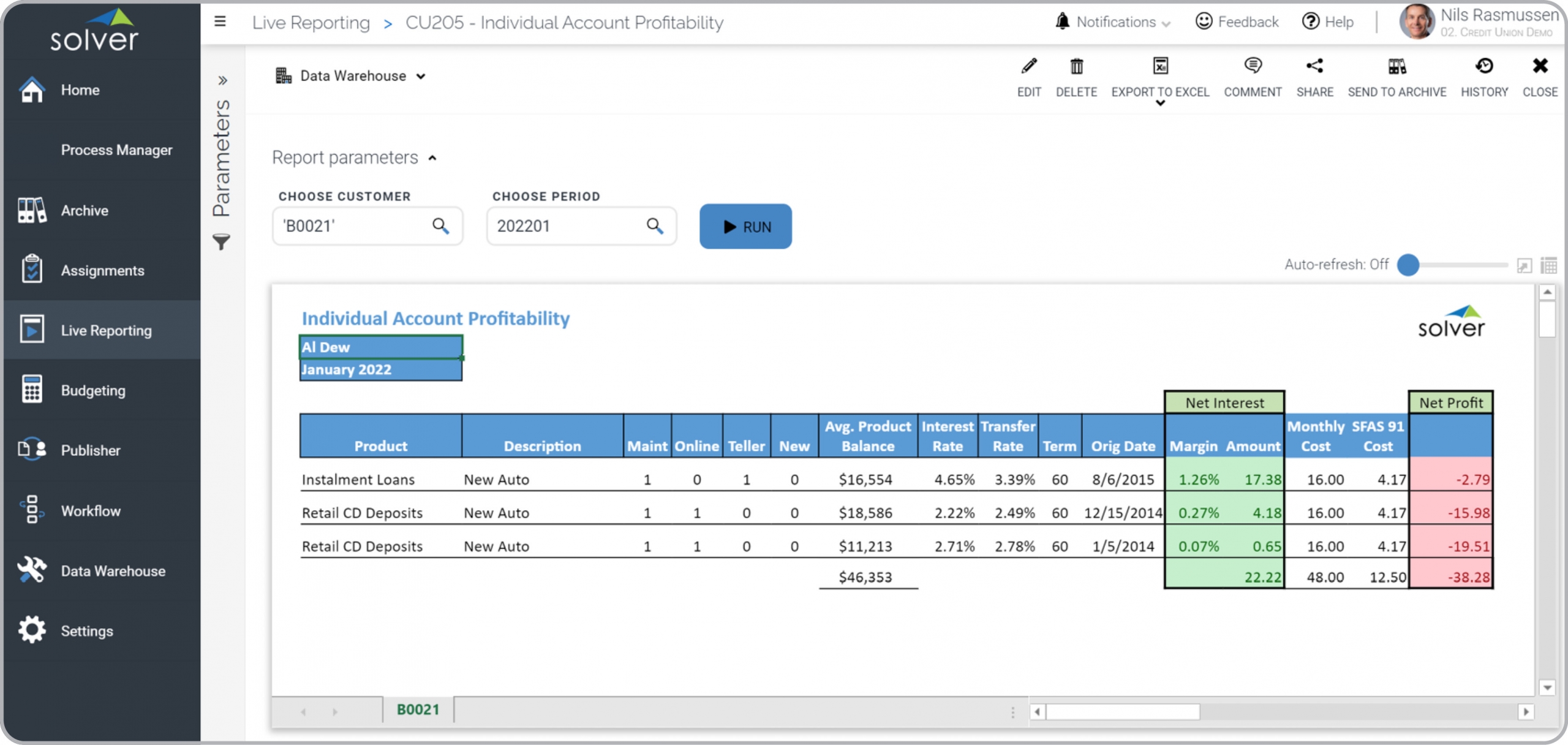Profitability by Member Account Report for Credit Unions
What is
an Account
Profitability Report
? Account Profitability Reports are considered operational reports and are used by account executives and analysts to review income, expenses and profitability for individual member accounts. Some of the main functionality in this type of report is that it enables the user to select the member account and the period to see the profitability by product transaction and in total for the account. The rows display the product transaction balances and the columns include: Average product balance, Interest rate, Transfer rate, Term, Origination date, Interest margin and amount, Monthly cost, SFAS cost, and Net profit. You find an example of this type of report below.
Purpose of Account Profitability
Profitability Report
s Credit Unions use Account Profitability Reports to give account managers an easy way to see how profitable a particular member account is. When used as part of good business practices in Production- and Account Management departments, a company can improve its profitability and account planning, and it can reduce the chances of uninformed member discussions leading to poor decisions and offerings.
Example of an Account
Profitability Repor
t Here is an example of an Account Profitability Report with product detail as well as key revenue and expense metrics. [caption id="" align="alignnone" width="2560"]
 Example of a Profitability by Member Account Report for Credit Unions[/caption] You can find hundreds of additional examples
here
Who Uses This Type of
Report
? The typical users of this type of report are: Account executives, production managers, branch managers, analysts.
Other Reports Often Used in Conjunction with Account
Profitability Report
s Progressive Production- and Account Management departments sometimes use several different Account Profitability Reports, along with financial statements, annual budgets, KPI dashboards, Member dashboards and other management and control tools.
Where Does the Data for Analysis Originate From? The Actual (historical transactions) data typically comes from member account systems and enterprise resource planning (ERP) systems like: Microsoft Dynamics 365 (D365) Finance, Microsoft Dynamics 365 Business Central (D365 BC), Microsoft Dynamics AX, Microsoft Dynamics NAV, Microsoft Dynamics GP, Microsoft Dynamics SL, Sage Intacct, Sage 100, Sage 300, Sage 500, Sage X3, SAP Business One, SAP ByDesign, Acumatica, Netsuite and others. In analyses where budgets or forecasts are used, the planning data most often originates from in-house Excel spreadsheet models or from professional corporate performance management (CPM/EPM) solutions.
What Tools are Typically used for Reporting, Planning and Dashboards? Examples of business software used with the data and ERPs mentioned above are:
Example of a Profitability by Member Account Report for Credit Unions[/caption] You can find hundreds of additional examples
here
Who Uses This Type of
Report
? The typical users of this type of report are: Account executives, production managers, branch managers, analysts.
Other Reports Often Used in Conjunction with Account
Profitability Report
s Progressive Production- and Account Management departments sometimes use several different Account Profitability Reports, along with financial statements, annual budgets, KPI dashboards, Member dashboards and other management and control tools.
Where Does the Data for Analysis Originate From? The Actual (historical transactions) data typically comes from member account systems and enterprise resource planning (ERP) systems like: Microsoft Dynamics 365 (D365) Finance, Microsoft Dynamics 365 Business Central (D365 BC), Microsoft Dynamics AX, Microsoft Dynamics NAV, Microsoft Dynamics GP, Microsoft Dynamics SL, Sage Intacct, Sage 100, Sage 300, Sage 500, Sage X3, SAP Business One, SAP ByDesign, Acumatica, Netsuite and others. In analyses where budgets or forecasts are used, the planning data most often originates from in-house Excel spreadsheet models or from professional corporate performance management (CPM/EPM) solutions.
What Tools are Typically used for Reporting, Planning and Dashboards? Examples of business software used with the data and ERPs mentioned above are:
- Native ERP report writers and query tools
- Spreadsheets (for example Microsoft Excel)
- Corporate Performance Management (CPM) tools (for example Solver)
- Dashboards (for example Microsoft Power BI and Tableau)
Corporate Performance Management (CPM) Cloud Solutions and More Examples
September 2, 2021
TAGS:
Reporting,
Solver,
profitability by product,
report writer,
Microsoft,
member,
template,
practice,
Acumatica,
customer,
Netsuite,
Finance,
credit union,
planning,
GP,
fintech,
Business Central,
excel,
ax,
forecast,
Budget,
Dynamics 365,
budgeting,
bank,
Cloud,
Software,
Tableau,
SAP,
example,
best,
Sage,
BC,
D365,
NAV,
Intacct,
financial institution,
CPM,
report,
branch,
SL,
Management,
dynamics,
Power BI,
profitability,
profitability by member account

